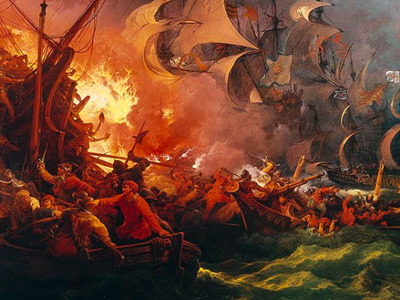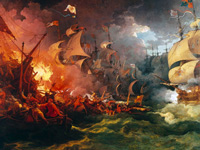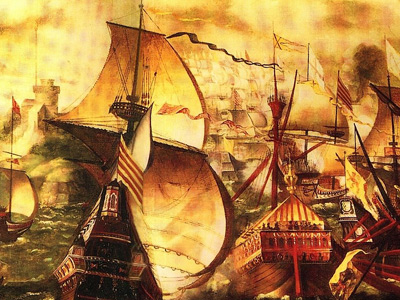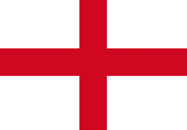Spanish Armada (1588)

Elizabeth's Tilbury Battle Address
On the day after the battle of Gravelines, the wind had backed southerly, enabling Medina Sidonia to move his fleet northward away from the French coast. Although their shot lockers were almost empty, the English pursued in an attempt to prevent the enemy from returning to escort Parma. On 2 August Old Style (12 August New Style) Howard called a halt to the pursuit in the latitude of the Firth of Forth off Scotland. By that point, the Spanish The Spanish Empire was a colonial empire governed by Spain and its predecessor states between 1492 and 1976. One of the largest empires in history, it was the first to usher the European Age of Discovery and achieve a global scale, controlling vast territory. It was one of the most powerful empires of the early modern period, reaching its maximum extent in the 18th century. were suffering from thirst and exhaustion, and the only option left to Medina Sidonia was to chart a course home to Spain, by a very hazardous route.
The Spanish Empire was a colonial empire governed by Spain and its predecessor states between 1492 and 1976. One of the largest empires in history, it was the first to usher the European Age of Discovery and achieve a global scale, controlling vast territory. It was one of the most powerful empires of the early modern period, reaching its maximum extent in the 18th century. were suffering from thirst and exhaustion, and the only option left to Medina Sidonia was to chart a course home to Spain, by a very hazardous route.
The threat of invasion from the Netherlands had not yet been discounted by the English The Kingdom of England was a sovereign state on the island of Great Britain from about 927, when it emerged from various Anglo-Saxon kingdoms, until 1 May 1707, when it united with Scotland to form the Kingdom of Great Britain. The Viking invasions of the 9th century upset the balance of power between the English kingdoms, and native Anglo-Saxon life in general. The English lands were unified in the 10th century in a reconquest completed by King Æthelstan in 927., and Robert Dudley, Earl of Leicester maintained a force of 4,000 soldiers at West Tilbury, Essex, to defend the Thames Estuary against any incursion up-river towards London.
The Kingdom of England was a sovereign state on the island of Great Britain from about 927, when it emerged from various Anglo-Saxon kingdoms, until 1 May 1707, when it united with Scotland to form the Kingdom of Great Britain. The Viking invasions of the 9th century upset the balance of power between the English kingdoms, and native Anglo-Saxon life in general. The English lands were unified in the 10th century in a reconquest completed by King Æthelstan in 927., and Robert Dudley, Earl of Leicester maintained a force of 4,000 soldiers at West Tilbury, Essex, to defend the Thames Estuary against any incursion up-river towards London.
On 8 August (18 August New Style) Elizabeth went to Tilbury to encourage her forces, and the next day, per legend, arrived on horseback in her own personal battle armour (and thus showing to the assembled warriors that she was prepared to fight with them in the ensuing battle to her own death). She gave to them her Royal address, which is probably her most famous speech. It survives in six different versions, each vying to be the authentic report of her words on that day. One version is as follows:
My loving people, we have been persuaded by some that are careful of our safety, to take heed how we commit ourselves to armed multitudes for fear of treachery; but, I do assure you, I do not desire to live to distrust my faithful and loving people. Let tyrants fear, I have always so behaved myself, that under God I have placed my chiefest strength and safeguard in the loyal hearts and goodwill of my subjects; and, therefore, I am come amongst you as you see at this time, not for my recreation and disport, but being resolved, in the midst and heat of battle, to live or die amongst you all – to lay down for my God, and for my kingdoms, and for my people, my honour and my blood even in the dust. I know I have the body of a weak and feeble woman; but I have the heart and stomach of a king – and of a King of England too, and think foul scorn that Parma or Spain, or any prince of Europe, should dare to invade the borders of my realm; to which, rather than any dishonour should grow by me, I myself will take up arms – I myself will be your general, judge, and rewarder of every one of your virtues in the field. I know already, for your forwardness, you have deserved rewards and crowns, and, we do assure you, on the word of a prince, they shall be duly paid you. In the mean time, my lieutenant general shall be in my stead, than whom never prince commanded a more noble or worthy subject; not doubting but by your obedience to my general, by your concord in the camp, and your valour in the field, we shall shortly have a famous victory over those enemies of my God, of my kingdom, and of my people.
After the victory, typhus swept the fleet, killing off thousands of English mariners. Elizabeth failed in her promise to pay the sailors, and of the few who did survive, even of the crew of the royal warship, Elizabeth, most expired destitute in the gutters of Margate.
HISTORY

RESOURCES
This article uses material from the Wikipedia article "Spanish Armada", which is released under the Creative Commons Attribution-Share-Alike License 3.0.
© Stories Preschool. All Rights Reserved.












